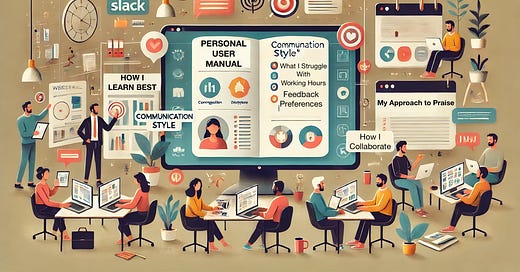Why You Should Have a Personal User Manual | #88
A simple but powerful tool to improve team collaboration. Create your Personal User Manual and reduce friction from day one.
Earlier this year, I gave a talk at a DesignBrew Meetup on the topic of design-driven collaboration. I’ve re-recorded that talk and posted it, and you can watch it here.
Of all the concepts I shared, one slide stood out: the Personal User Manual. After the talk, multiple attendees mentioned it was the most thought-provoking and useful idea they took away.
It’s simple in concept, but powerful in practice.
A Personal User Manual is a document where you outline how you like to work; your preferences, communication style, feedback approach, and more.
It’s a tool that helps others understand you better and collaborate with you more effectively. And in today’s cross-functional, fast-paced environments, that kind of clarity can really help the culture in teams and in your company.
So Why Create a Personal User Manual?
If you’re someone who:
Works across multiple projects
Collaborates with different PMs/leaders or stakeholders regularly
Is part of a shared resource pool or enabling team
… then a Personal User Manual can remove a huge amount of the guesswork in how people work with you. It opens the door to clearer expectations, smoother collaboration, and fewer misunderstandings.
For example:
If a PM knows you’re happy to receive feedback via Slack threads, they’ll feel more confident giving it there, rather than waiting for a formal meeting.
If praise in public Slack channels makes you uncomfortable, you can say that upfront and avoid that awkward moment entirely.
The result?
Less friction
Faster decision-making
A more cohesive team environment
Try it yourself and fill out your Personal User Manual
Below is the full set of questions that you should answer yourself along with examples of what kind of answers you can have. Take 15 - 20 minutes to reflect and fill it out. Then share it with your team or manager, especially when starting a new project or joining a new team.
You might be surprised by how many assumptions others are making about you (and vice versa). I’ve seen teams catch blind spots and misunderstandings within minutes of sharing their manuals.
The below template is also over on my Miro Template which you can find here. Feel free to copy that board if you see anything that might be useful.
Personal User Manual - Template
My Role and Contributions
What’s my primary responsibility in the team?
What are the key areas where I can add value?
My Communication Style
How do I prefer to communicate (e.g., Slack, email, or in-person)?
What’s the best way to get a quick response from me?
How I Learn Best
What’s my preferred way of learning (e.g., visuals, discussions, or documents)?
How do I stay motivated to absorb new information?
My Approach to Feedback
What’s my style for giving feedback?
How do I like to receive feedback (e.g., direct, in writing)?
My Approach to Praise
How do I like receiving praise? (e.g., public/private slack messages, Recognition tools, Email)
How do I prefer to give Praise?
How I Collaborate
What collaboration styles work for me (e.g., brainstorming, structured meetings)?
How do I involve others in my work?
How to Approach Me
What’s the best way to raise an urgent issue?
How can we work through sensitive topics?
My Working Hours
What hours am I available?
What boundaries do I have for after-hours work?
What Keeps Me Productive
What working environment helps me focus?
What habits or tools help me stay on track?
My Decision-Making Style
How do I approach decisions (e.g., data-driven, collaborative)?
What do I need to feel confident about a decision?
What Gets Under My Skin
What behaviours throw me off balance?
How can we avoid or manage those situations?
Things I’m Great At
What are my areas of expertise?
How can I best support my teammates?
Things I Struggle With
What challenges do I face sometimes?
When might I need extra support?
The Personal User Manual is one of those tools that seems almost too simple to be useful - until you try it.
It’s not just about making things easier for yourself. It’s about creating psychological safety for yourself and your co-workers, building stronger team dynamics, and helping others do their best work with you.
If you’re onboarding into a new role or kicking off a new collaboration, give this a try. Share it with your team. You’ll be amazed how much it improves clarity, trust, and alignment from day one.
Already using something like this with your team? I’d love to hear how it’s working for you - drop me a message or comment below.
Ep12 - Design-Driven Collaboration With Product Managers | #85
This episode is a post-recording of a talk I gave at a DesignBrew Meetup in Dublin. After a few requests, I recorded this version so attendees could pass it on to their teams.





